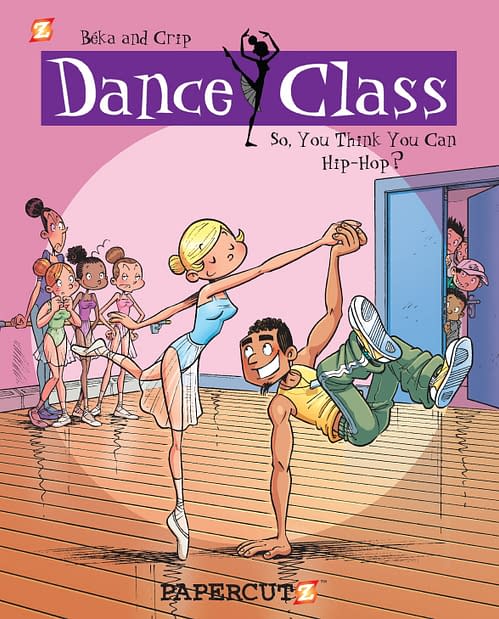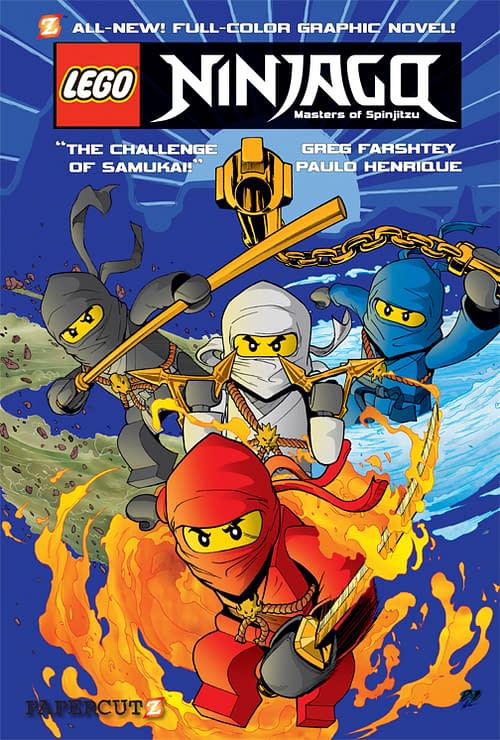Posted in: Comics | Tagged: Jim Salicrup, Ninjago, Papercutz, smurfs
The Papercutz Manifesto – Jim Salicrup Discusses How His Company Is Succeeding With Demographics The Direct Market Often Ignores
Whenever one talks about the future of comics, part of the answer always includes talk of expanding the fan base and reaching demographics currently not being served. Despite all the talk though, there remain areas where comics could, and should, be reaching out to yet fail to do so.

Jim, one of the biggest complaints I have written about that I have for the "Big Two" is that between the two of them, they have maybe one comic (well, more a series of miniseries) between the two of them that is aimed at tween girls, and that's Oz. Both the dad in me and the former retailer in me see that this as a lost opportunity, both in terms of hooking a new audience and getting them into comic shops. Even with Oz, it seems like the main audience there is the one that will later pick it up as a hardcover at Barnes and Noble rather than as a monthly in a comic shop.
This is definitely an opportunity that your company is not passing on though with product like Dance Class and Disney Fairies, just to name a couple. What is it that you see in this audience that they don't? Similarly, are comic shops a venue that works for you, or is your business model more focused on more traditional booksellers?
Keeping in mind that the direct sales comic book market was essentially created to distribute comics from the "Big Two," it works very well at doing just that. Trying to sell other types of comics through this distribution system is a real challenge, even for the Marvel and DC. Marvel's Wizard of Oz adaptations are a great example of what we try to do at Papercutz – a comic series that truly is for all ages. I buy multiple copies of the Oz comics and the collections, for myself and for several friends. I believe its appeal to older comics fans is what makes it a success, that if it only appealed to children, it would be struggling.
Along similar lines, our Smurfs graphic novels also appeals to all ages — especially older fans who loved the 80s cartoon series, and, to a lesser extent, fans of European comics, and that's why The Smurfs is our strongest seller in the comic book shops. Sure, kids love Smurfs too, but I suspect that these books are being bought for them in comic book shops by parents or relatives who normally frequent comic book shops. I'm sure there are also kids who shop at comic book shops and buy The Smurfs too, but I bet they're in the minority.

We're very thankful for Diamond's help and support on The Smurfs. Working with Diamond we published a dollar preview comic and two Halloween Smurfs min-comics that helped greatly to allow fans to sample these comics either at a very low price or virtually for free. Our very first Free Comic Book Day comic was also The Smurfs and Geronimo Stilton, which also helped tremendously.
Reviews were also very helpful. We're publishing the original Smurfs comics created by Peyo, and critics were quick to point out how amazing these comics truly are. Not many fans in the US realized that The Smurfs originally started as comic characters back in 1958, as they're much more familiar with the 80s cartoon series. Many fans enjoyed the opportunity to finally read the original comics, some of which had never been available before in English. Critics also praised the excellent work by award-winning designer Adam Grano, and the artful lettering by award-winning letterer Janice Chiang, and were happy with how Papercutz has repackaged The Smurfs in highly affordable formats.
So, while we're very happy with the support we're getting on The Smurfs, and happy for the success of Marvel's Oz adaptations, we realize that comic book stores are still a challenging market for titles that may appeal more to younger audiences. While there are comic book stores that actively support comics and graphic novels for all ages — and we're very appreciative of their efforts– most comic book stores still understandably focus most of their efforts on retaining and attracting new customers for the many super-hero comics they sell.
Even when some comic book stores do carry comics that may appeal to children, especially girls, it's a tricky proposition. For example, if young girls haven't been shopping at comic book stores, why will they suddenly start now? How will they know that these stores now have material that may appeal to them? That is really a major challenge, and unless that's addressed, it's unlikely enough girls will ever make it into the stores to check out these new comics and graphic novels.
So, what this all means is that many of our titles find their audience at traditional bookstores, simply because children know there are children's sections at these stores with books created just for them. In these children's sections, characters such as Nancy Drew, The Hardy Boys, Geronimo Stilton, Disney Fairies, and many more are very well known. This audience instantly recognizes the parodies we feature in Papercutz Slices, such as Harry Potty, Percy Jerkson, and Hunger Pains. And at this point, titles such as Dance Class, Ernest & Rebecca, and Sybil the Backpack Fairy may have their best shot at building a following in traditional bookstores, but we're thankful for all the support we get from comic book stores. Our next Free Comic Book Day comic will feature The Smurfs and Disney Fairies, but will have a few pages of Dance Class and Ernest & Rebecca as well (single pages from both series are designed to work either separately or as part of a bigger story, so it'll work nicely).

When we had success with The Smurfs we took that opportunity to let both comic bookstore customers and owners know about another one of our success stories– Geronimo Stilton. By including Geronimo Stilton in with The Smurfs in our first Free Comic Book Day comic, storeowners had little to lose — they already knew they had customers who liked The Smurfs. When some of their younger customers were exposed to the Geronimo Stilton content, they may have been surprised to discover that comics based on this super-successful children's series even existed! As a result, they asked the comic book storeowners about it, and we saw our orders on Geronimo Stilton increase dramatically in comic book stores.
Ultimately it may just come down to us figuring out as many ways as possible for us to get our comics in front of the people who will enjoy them. We're on comiXology, we're getting into more mass-market outlets such as Wal-Mart and Target, we're in school book clubs and book fairs, we're in schools and libraries. We love the comics we're publishing and we hope we can expose them to as many people as possible.
In your business model then, are comic shops even necessary? I don't mean that as a knock on the direct market, but at the same time, it's not a market that seems very welcoming to what you offer.
Any potential market is necessary for a small publisher like us! Ironic, isn't it, that comic shops would be considered not "very welcoming" to a publisher of comics? But as I said before, there are quite a few comic stores that are making a concerted effort to support comics for all ages. Just like in regular bookstores, we're seeing sections of stores being dedicated to comics for kids. Recently we hired Janna Morishima as our Director of Marketing, and getting those kids graphic novel sections into bookstores is something she helped make a reality.
But while that is certainly a very positive move, and we certainly welcome that, there's even an unintended side effect to that… some of our titles really are suitable for all ages, meaning adults as well as children. Unfortunately, sometimes when titles are shelved in sections explicitly labeled for children, some adults won't even consider that they could possibly enjoy that material. Titles such as Classics Illustrated, or even The Smurfs or Ernest & Rebecca, which can be enjoyed by adult audiences, suffer by being shelved in the children's section. There's good news, however, more and more adults are finding books in the "Young Adult" sections, such as Harry Potter and the Twilight saga that they can enjoy.
Way back when, all comics were considered, in a not very good way, suitable only for children. For decades folks such as Stan Lee and Will Eisner fought the battle to have comics accepted as a legitimate art form able to produce sophisticated material that even adults could enjoy. Papercutz publisher, Terry Nantier, was a real pioneer, along with a few others, publishing material that was worthy of an adult audience– everything from collections of classic comic strips such as Terry and the Pirates to English editions of great European graphic novels through his company NBM Publishing. It's safe to say that in many ways that battle has been won. Bookstores, libraries, and most importantly, audiences, have accepted comics and graphic novels for adults. But along the way, many of the traditional outlets for comics for younger audiences either vanished or no longer carry comics. And that is where a lot of our efforts are focused, to figure out ways to bring our titles to as large an audience as possible.

While we're super thankful to publish Ninjago, we're still working as hard as we can to help titles such as Ernest & Rebecca and Dance Class find their audiences.













